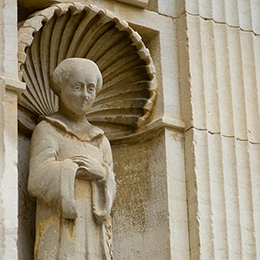In the year 52BC, after their conquest of Gaul, the Romans founded the town of Autun and brought vines to the region to slake the Gauls’ growing thirst for wine, which had previously been imported. Winegrowing began to take off, and the first record of its existence dates back to the fourth century AD. In the Middle Ages, after the fall of the Roman Empire, the two monastic orders of Cîteaux and Cluny really helped spread vine cultivation. Through their work, they helped the region take off and contributed largely to the wines’ growing reputation.
The Romans drank their wine watered down
Wine drunk in Roman times was very different to the wine we drink today.
It was seasoned with herbs, spices and fruit, and enriched with honey or even salt for better shelf life.
Another difference is that the Romans always drank their wine watered down.
They believed that only the Gods drank their wine neat. Some historians also believe that diluting wine was an indirect way of putting off and limiting drunkenness. For example, a simple Legionnaire received wine rations cut with 24 parts water to one part wine.
Before a banquet, the host would bring together several guests for a “symposium” during which they would decide upon the amount of water they would use to cut the wine to be drunk that evening.
The Gauls were considered to be barbaric because they drank their wine straight up!

As far back as the 4th century, the drink was discovered by certain Celts who traveled to Italy. When they returned, some brought back the culture of vinegrowing and winemaking to the Bourgogne region. At the time, Bibracte on Mont Beuvray was the capital of the Eduens Celtic tribe. Archeological digs there have revealed the remains of hundreds of thousands of amphora brought back from Italy and dating from the second or first century BC. They provide proof of a significant trade in wine between Rome and Gaul.

In the year 52BC, the Romans invaded Gaul and built the town of Autun in the Bourgogne region, and Bibracte was abandoned. The Roman elite planted many vines during the next two centuries. Gradually, these new crops modeled the landscape. Bourgogne was promised a great future, and seemed to flourish during the second half of the first century.
Over time, the Romans also acquired expertise in terms of vine cultivation and winemaking. On the tables of the Bourgogne region, wine even began to replace Celtic beer as the preferred beverage. The barrel, invented by the Gauls, took over from the amphora for wine transportation, and wine drinking became increasingly popular. From the second century onwards, vines and wines were a major economic and cultural influence across the region.
The vineyards of Bourgogne, the result of several centuries of winegrowing, had already established their reputation for producing quality wines as early as the fourth century. Eumenes, the celebrated orator and President of the University of Autun, mentioned it in a speech dedicated to the glory of the Emperor Constantine Augustus in 312. This text is the first written record of the existence of the terroir of the Bourgogne region, as far back as the Roman Empire.

During the Middle Ages, the understanding of winemaking continued to grow. In Bourgogne, people gradually worked out which were the best terroirs upon which to make wine. And this is how the nobles came to plant their vines on the hillsides around Beaune.
However, in the fifth century, the Barbarian invasions brought about the fall of the Roman Empire. Then, with the rise of Christianity, the Bourgogne region saw growth in abbeys and monasteries. Cluny was founded in 909 and Cîteaux in 1098. The monks combined prayer and labor, developing their farming activity, which rapidly came to include the cultivation of vines. The vines then became the property of the Cistercian and Cluniac monks, who were largely responsible for the popularity of Bourgogne.